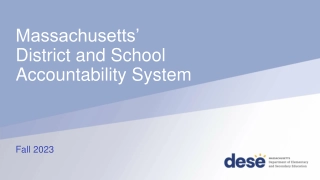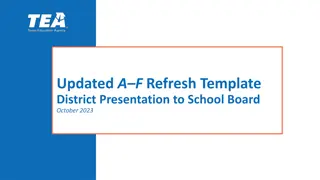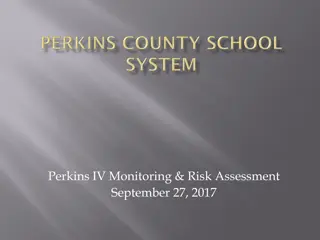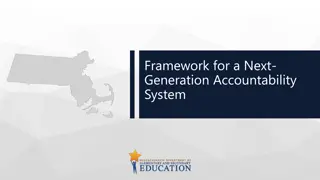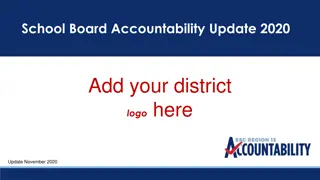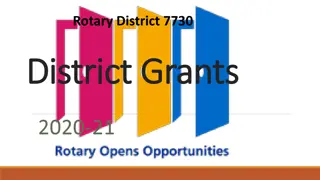Understanding A-F Accountability System for District Success
New Texas Education Agency's accountability system assigns letter grades to districts based on various performance indicators such as student achievement, progress, and readiness. Districts receive overall and domain-specific grades, with campuses evaluated separately. Accountability ratings are made public on specific dates, determining if improvements are required.
- Accountability System
- Texas Education Agency
- District Success
- Student Achievement
- Performance Reporting
Download Presentation

Please find below an Image/Link to download the presentation.
The content on the website is provided AS IS for your information and personal use only. It may not be sold, licensed, or shared on other websites without obtaining consent from the author. Download presentation by click this link. If you encounter any issues during the download, it is possible that the publisher has removed the file from their server.
E N D
Presentation Transcript
A-F Accountability Comprehending the new accountability system for district success.
Commissioners Final Decisions for Commissioner s Final Decisions for 2018 Accountability 2018 Accountability TEXAS EDUCATION AGENCY ACADEMICS PERFORMANCE REPORTING
Important Links TEA ACCOUNTABILITY MANUAL https://tea.texas.gov/2018accountabilitymanual.aspx TEA SCALING TOOL https://rptsvr1.tea.texas.gov/perfreport/account/2018/scaling_tool.html S TAAR Raw Score Conversion https://tea.texas.gov/Student_Testing_and_Accountability/Accountability/State_Accoun tability/Performance_Reporting/STAAR_Raw_Score_Conversion_Tables_for_2017%E2%80%93201 8/
A-F Letter Grades A = Exemplary Performance B = Recognized Performance C = Acceptable Performance D= In Need of Improvement F = Unacceptable Performance
Overview BEST OF ACHIEVEMENT OR PROGRESS 70% of Overall Grade 30% of Overall Grade
Student Achievement Domain Districts will receive a letter grade in each domain and an overall letter grade. Accountability tables post on August 7, 2018 Districts receive ratings on August 14, 2018 Accountability ratings made public on August 15, 2018 Campuses will NOT receive their letter grade until 2018-2019 Campuses will receive a Met Standard rating if their scale score is 60 or greater, and Improvement Required if their scale score is 59 or below.
Student Achievement Domain Elementary/Middle Schools Weight STAAR 100% High Schools, K 12, and Districts STAAR 40% College, Career, and Military Readiness (CCMR) 40% Graduation Rate 20%
Student Achievement Domain STAAR One point is given for each percentage of assessment results that are at or above the following:* Approaches Grade Level or Above Meets Grade Level or Above Masters Grade Level Percentage of Assessments at Approaches Grade Level or Above + Percentage of Assessments at Meets Grade Level or Above + Percentage of Assessments at Masters Grade Level Three *Substitute assessments are included at the Meets Grade Level standard.
Student Achievement Domain Approaches G.L. + Meets G. L. + Masters G.L. Score 3 Formula for Success and Recognition as an A level campus 90% Approach GL 60% Meet GL 30% Master GL Score of 60
Student Achievement Domain College Ready Career Ready Meet criteria of 3 on AP or 4 on IB examinations CTE coherent sequence coursework completion and credit aligned with approved industry-based certifications (one-half point credit) Meet TSI criteria (SAT/ACT/TSIA/College Prep course) in reading and mathematics Earn industry-based certification Complete a course for dual credit (9 hours or more in any subject or 3 hours or more in ELAR/mathematics) Graduate with completed IEP and workforce readiness (graduation type code of 04, 05, 54, or 55) Earn an associate s degree Be admitted to postsecondary industry certification program* Complete an OnRamps course* Meet standards on a composite of indicators indicating college readiness* Military Ready Enlist in the United States Armed Forces *Implementation in 2019 and beyond
Student Achievement Domain CCMR One point is given for each annual graduate who accomplishes any one of the CCMR indicators, except for CTE coherent sequence graduates. One-half point is given for each CTE coherent sequence graduate who completes coursework aligned to the approved list of industry-based certifications.* Number of Graduates Who Accomplish Any One of the CCMR Indicators Number of 2017 Annual Graduates *This is for graduates who meet no other CCMR indicator.
Student Achievement Domain CTE Coherent Sequence to Industry-Based Certifications Transition Plan For 2018 and 2019, CTE coherent sequence graduates who complete and receive credit for at least one course aligned with CTE industry-based certification earn one-half point. For 2020 and 2021, CTE coherent sequence graduates who complete and receive credit for a pathway of courses toward an industry-based certification earn one-half point. For 2022 and beyond, only graduates who earn an industry-based certification earn one point.
Student Achievement Domain Graduation Rate High school graduation rates include the four-year, five-year, or six-year longitudinal graduation rate (with state exclusions) or annual dropout rate, if the graduation rate is not available.
Campus Performance How did you and your campus do? Download the Domain 1 Projection Tool www.esc19.net Click on Programs, then select Research and Analysis, then click on Accountability Resources, and scroll down to the Domain 1 Projection Tool.
School Progress Domain Elementary, Middle, High Schools, K 12, and Districts The higher scaled score of Part A: Academic Growth or Part B: Relative Performance is used for the School Progress domain rating.
School Progress Domain Part A: Student Growth School Progress, Part A: Academic Growth includes all assessments with a STAAR progress measure.* Districts and campuses (including high schools) earn credit for results that maintain proficiency or meet growth expectations on STAAR. *Substitute assessments are not included.
School Progress Domain Part A: Student Growth Current-Year Performance on STAAR Approaches Grade Level Does Not Meet Meets Grade Level Masters Grade Level Met or Exceeded Growth Expectation=1 point, Else = 0 points Met or Exceeded Growth Expectation=1 point, Else = 0.5 point Prior-Year Performance on STAAR Does Not Meet 1 point 1 point Met or Exceeded Growth Expectation=1 point, Else = 0 points Met or Exceeded Growth Expectation=1 point, Else = 0.5 point Approaches Grade Level 1 point 1 point Met or Exceeded Growth Expectation=1 point, Else = 0.5 point Meets Grade Level 0 points 0 points 1 point Masters Grade Level 0 points 0 points 0 points 1 point
School Progress Domain Part A: Student Growth Current-Year Performance on STAAR Alternate 2 Prior-Year Performance on STAAR Alternate 2 Level I: Developing Level II: Satisfactory Level III: Accomplished Met or Exceeded Growth Expectation=1 point, Else = 0 points Level I: Developing 1 point 1 point Met or Exceeded Growth Expectation=1 point, Else = 0.5 point Level II: Satisfactory 0 points 1 point Level III: Accomplished 0 points 0 points 1 point
School Progress Domain Part B: Relative Performance School Progress, Part B: Relative Performance evaluates the achievement of all students relative to districts or campuses with similar socioeconomic statuses.
School Progress Domain Part B: Relative Performance Elementary Schools Student Achievement STAAR component results compared to elementary schools with similar percentages of economically disadvantaged students Part B: Relative Performance Middle Schools Student Achievement STAAR component results* compared to middle schools with similar percentages of economically disadvantaged students *Substitute assessments are included at the Meets Grade Level standard.
School Progress Domain Part B: Relative Performance High Schools, K 12, and Districts with CCMR Component Student Achievement STAAR component* and CCMR component results averaged compared to districts or campuses with similar percentages of economically disadvantaged students Part B: Relative Performance High Schools, K 12, and Districts without CCMR Component Student Achievement STAAR component* results compared to districts or campuses with similar percentages of economically disadvantaged students Part B: Relative Performance AEA Charter Schools and Campuses Alternative education accountability (AEA) charter schools and campuses are not evaluated on School Progress, Part B due to the small number of districts and campuses used for comparison. *Substitute assessments are included at the Meets Grade Level standard.
Campus Performance How did you and your campus do? What percentage of students met or exceeded the STAAR progress measure? For students showing Limited Growth, how many maintained progress or stayed at the Masters grade level? Enter your results in the TEA scaling tool to understand your domain 2 score. Using your economically disadvantaged rate, find your relative performance score for domain 2.
Closing the Gaps Domain Economically Disadvantaged
Closing the Gaps Domain Student Groups Components All Students African American Hispanic White American Indian Asian Pacific Islander Two or More Races Economically Disadvantaged Current and Former Special Education Current and Monitored English Learners (through fourth year as allowed by ESSA) Continuously Enrolled/ Non-Continuously Enrolled Academic Achievement in Reading and Mathematics (At Meets Grade Level or Above) Growth in Reading and Mathematics (Elementary and Middle Schools) 4-year Federal Graduation Rate (High Schools, K 12, and Districts) College, Career, and Military Readiness (High Schools, K 12, and Districts) Student Achievement Domain Score: STAAR Component Only (Elementary and Middle Schools) English Language Proficiency Status (USDOE denied the requested waiver.)
Closing the Gaps Domain Academic Achievement* STAAR (percentage at Meets Grade Level or above) ELA/Reading Mathematics Targets By student group and subject area No safe harbor *Substitute assessments are included at the Meets Grade Level standard.
Closing the Gaps Domain Growth Elementary and Middle Schools (School Progress domain) ELA/Reading Mathematics Graduation Rate High Schools, K 12, Districts* 4-year Federal Graduation Rate (without exclusions) Targets By student group For Growth, by subject area No safe harbor *For high schools, K 12s, and districts without a federal four-year graduation rate, the STAAR Growth Status is used, if available.
Closing the Gaps Domain School Quality and Student Success High Schools, K 12, and Districts College, Career, and Military Readiness* Elementary and Middle Schools Student Achievement Domain Score: STAAR Component Only Targets By student group No safe harbor *Evaluates annual graduates plus students in grade 12 during school year 2016 17 as reported in TSDS PEIMS who did not graduate. If a high school, K 12, or district does not have CCMR data, the Student Achievement Domain Score: STAAR Component Only is used, if available.
Closing the Gaps Domain Participation Status 95 percent target Based on STAAR and TELPAS assessment results Substitute assessments are included as participants. No Authentic Academic Response (NAAR) designations are included. Medical exception and medically exempt designations are not included in the numerator or denominator. Should the participation status for the all students group or any student group fall below 95 percent, the denominator used for calculating the Closing the Gaps Academic Achievement component is adjusted to include the necessary number of assessments to meet the 95 percent threshold.
Closing the Gaps Domain Adjusted Academic Achievement Performance Calculation Example The campus s participation rate for ELA/reading is 93 percent. 93 scored answered documents 100 scored, absent, or other answer documents The performance denominator must be adjusted to include enough assessments to meet the 95 percent target.
Closing the Gaps Domain Adjusted Academic Achievement Performance Calculation Example (cont d.) Original ELA/Reading Academic Achievement Performance Calculation: 53 assessments at Meets Grade Level or Above standard 93 scored assessments that meet accountability subset (out of the 100 total assessments) =57% Adjusted ELA/Reading Academic Achievement Performance Calculation: 53 assessments at Meets Grade Level or Above standard 95 assessments (93 scored plus 2 absent/other) =56%
Closing the Gaps Domain Elementary, Middle, High Schools, K 12, and Districts The district or campus must have ten reading and ten mathematics assessment results in the Academic Achievement component to be evaluated on the Closing the Gaps domain. Cumulative performance for each component is based on the total number of eligible student groups that meet minimum-size criteria. The minimum sizes are ten assessments for all students and 25 assessments for student groups. The number of indicators met for each component is totaled and then divided by the total count of indicators evaluated, resulting in an overall percentage for each of the domain components.
Closing the Gaps Domain Elementary, Middle, High Schools, K 12, and Districts The following components must have a minimum of five indicators that meet minimum size to be included in the Closing the Gaps calculation: Academic Achievement, STAAR Growth Status, and Student Achievement Domain Score: STAAR Component Only The remaining components only require one evaluated indicator. Percentages for each component are then weighted based on the district or campus type to calculate an overall domain score.
Closing the Gaps Domain Example of Minimum Number of Indicators Evaluated: Academic Achievement African Amer- ican Two or More Races Special Ed - Current Contin- uously Enrolled Total Indicators Evaluated All Econ Disadv Hispanic White Students Reading: 75 13 26 26 10 24 13 62 Number of Assessments Met Minimum Size Mathematics: Number of Assessments Met Minimum Size Y N Y Y N N N Y 4 70 11 23 26 10 22 10 60 Y N N Y N N N Y 3 7 Total Indicators Evaluated Academic Achievement Included? Yes
Closing the Gaps Domain Weight1 Elementary/Middle Schools Academic Achievement 30% STAAR Growth Status 50% English Language Proficiency2 10% Student Achievement Domain Score: STAAR Component Only 10% 1 These weights reflect a planned amendment to the ESSA state plan. 2 Due to changes to the TELPAS, Texas will request a waiver from the U.S. Department of Education to waive the English Language Proficiency component for 2018 accountability. If granted, the English Language Proficiency component weight will be distributed proportionally.
Closing the Gaps Domain Weight1 High Schools, K 12, AEAs, and Districts Academic Achievement 50% Federal Graduation Status (If not available, STAAR Growth Status) 10% English Language Proficiency2 10% College, Career, and Military Readiness (If not available, Student Achievement Domain Score: STAAR Component Only) 30% 1 These weights reflect a planned amendment to the ESSA state plan. 2 Due to changes to the TELPAS, Texas will request a waiver from the U.S. Department of Education to waive the English Language Proficiency component for 2018 accountability. If granted, the English Language Proficiency component weight will be distributed proportionally.
Closing the Gaps Domain Example of Elementary School Closing the Gaps Domain Calculation The sample elementary campus has met the minimum number of evaluated indicators in all four components. Percentage of Evaluated Indicators Met Component Weight Total Points Academic Achievement 69 30% 20.7 STAAR Growth Status 83 50% 41.5 English Language Proficiency* 100 10% 10 Student Achievement Domain Score: STAAR Component Only 60 10% 6 Closing the Gaps Domain Score 78 *Due to changes to the TELPAS, Texas will request a waiver from the U.S. Department of Education to waive the English Language Proficiency component for 2018 accountability. If granted, the English Language Proficiency component weight will be distributed proportionally.
2018 Alternative Education Accountability Alternative education accountability (AEA) charter schools and campuses are evaluated in the domains, components, and indicators as explained in this presentation. Alternative procedures applicable to the graduation rate and annual dropout rate calculations are provided for approved campuses and charter schools serving at-risk students in alternative education programs. Targets and cut-points established by campus type have AEA-specific targets and cut-points, as applicable. AEA charter schools and campuses are not evaluated on School Progress, Part B due to the small number of districts and campuses used for comparison.
Inclusion of English Learners in 2018 Accountability English Learners (ELs) who are year one in U.S. schools are excluded from accountability performance calculations. Due to changes to the Texas English Language Proficiency Assessment System (TELPAS), Texas will request a waiver from the U.S. Department of Education to exclude EL students who are year two in U.S. schools from 2018 performance calculations. (THIS WAIVER WAS DENIED) TELPAS will be evaluated as a lagging indicator measuring results from 15/16 to 16/17 STAAR Alternate 2 assessment results will be included regardless of an EL s years in U.S. schools. Asylees, refugees, and students with interrupted formal education (SIFEs) are not included in state accountability until their sixth year of enrollment in U.S. schools.
Scaling Processes Districts Scaled scores were created to align letter grades and scores used in the A F academic accountability system to the common conception of letter grades. Campuses Scaled scores were established by campus type.
Weighting of Overall Rating Step 1: Determine the better outcome of the Student Achievement and the School Progress domain scaled scores. Step 2: Weight the better outcome of the Student Achievement or the School Progress domain scaled score at 70 percent. Step 3: Weight the Closing the Gaps domain scaled score at 30 percent. Step 4: Total the weighted outcome of the two scaled scores to calculate the overall score.


